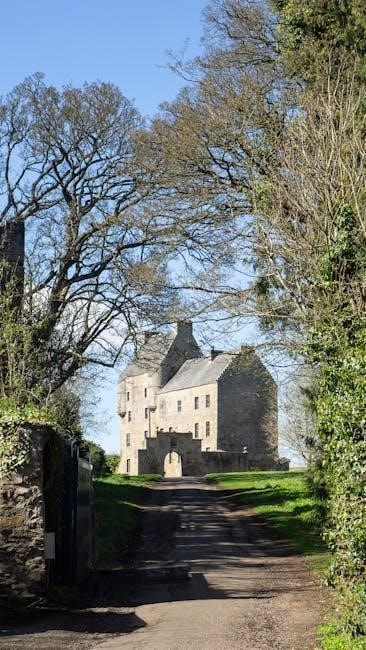
Overview of “Blue Bells of Scotland” for Trombone
“Blue Bells of Scotland” is a well-known Scottish folksong, notably arranged by Arthur Pryor for trombone․ This rendition, often accompanied by piano or concert band, presents a cornerstone of trombone literature, challenging players technically and musically․
The Popularity of the Scottish Folksong
“Blue Bells of Scotland” enjoys widespread popularity as a cherished Scottish folksong, appreciated for its simple yet evocative melody․ Its appeal transcends generations, contributing to its enduring presence in musical traditions․ The song’s arrangement for trombone, particularly Arthur Pryor’s version, further amplified its reach within the instrumental music community․ Its accessibility and charm have made it a staple in various musical settings, solidifying its place in popular culture․ The song’s initial publication dates back to 1801 when it was written by Dora Jordan․
Arthur Pryor’s Arrangement
Arthur Pryor’s arrangement of “Blue Bells of Scotland” is iconic․ Circa 1899, it transformed the folksong into a celebrated trombone solo, showcasing virtuosity and musicality, solidifying its place in trombone repertoire․
Pryor’s Trombone Solo Setting (circa 1899)
Around 1899, Arthur Pryor composed his trombone solo setting of “Blue Bells of Scotland,” a work now considered a cornerstone of trombone literature․ This arrangement transformed a simple folk melody into a dazzling display of technical prowess and musical expression․ Pryor’s setting quickly became popular, performed by leading trombonists worldwide․ The piece demands exceptional range, flexibility, legato technique, and double tonguing, making it a significant challenge․ It remains a test piece, showcasing a trombonist’s skill, artistry, and mastery of the instrument․
Key Features of Pryor’s Arrangement
Pryor’s arrangement of “Blue Bells of Scotland” is characterized by its theme and variations structure, allowing for diverse musical explorations․ The solo trombone part necessitates a wide range, pushing players to their upper and lower registers․ Flowing legato passages contrast with rapid double-tongued sections, demanding exceptional flexibility․ The arrangement showcases the trombone’s lyrical capabilities alongside its potential for virtuosic display․ These features, combined with its inherent melodic charm, have cemented its place as a pivotal piece in the trombone repertoire․ It remains a favorite for both performers and audiences․
Technical Challenges for the Trombonist
Pryor’s “Blue Bells of Scotland” presents considerable technical hurdles for trombonists․ Extended range is essential, requiring command of both high and low registers․ Fluid legato playing must be coupled with exceptional flexibility for seamless transitions․ The piece is infamous for its fast double tonguing passages, testing articulation skills․ Successfully navigating these challenges demands dedicated practice and a solid foundation in trombone technique․ Mastery of this arrangement demonstrates significant proficiency and control, establishing it as a benchmark for intermediate to advanced players seeking to hone their abilities․
Available Sheet Music and Formats
Sheet music for “Blue Bells of Scotland,” arranged by Arthur Pryor, is readily available online․ Formats include downloadable PDFs and MIDI files, catering to various needs for practice and performance purposes․
PDF Downloads
Numerous websites offer free PDF downloads of “Blue Bells of Scotland” sheet music, particularly Arthur Pryor’s arrangement․ These downloads often include the complete score, featuring both the trombone solo part and the piano accompaniment; Various versions are accessible, catering to different skill levels and preferences, allowing trombonists to readily access and print the music for practice and performance․ Ensure the PDF is complete and legible before using it for serious practice or performance․ Several sites provide legal access to free sheet music in PDF format․
MIDI Files
In addition to PDF sheet music, MIDI files of “Blue Bells of Scotland,” particularly Pryor’s trombone arrangement, are often available online․ These MIDI files can be useful for practice, allowing trombonists to hear the melody and accompaniment․ MIDI files also provide a digital representation of the music that can be manipulated for tempo, pitch, or instrumentation, facilitating customized practice sessions․ However, note that a MIDI file is a digital representation and lacks the nuances of a live performance, so it is not a substitute for listening to recordings․

Instrumentation and Performance Context
“Blue Bells of Scotland,” arranged for trombone, commonly features piano accompaniment․ Performances also occur with concert bands, orchestras, or brass bands, showcasing its versatility and enduring appeal in various musical settings․
Common Accompaniments: Piano, Concert Band, Orchestra
Arthur Pryor’s arrangement of “Blue Bells of Scotland” for trombone is versatile in its performance contexts․ The most frequent accompaniment is piano, providing harmonic support for the solo trombone’s melodic variations․ Concert band arrangements offer a fuller, more robust sound, suitable for larger ensembles․ Orchestral settings, while less common, add a layer of sophistication through string and woodwind textures․ Brass band arrangements provide a unique and powerful sonic landscape for the trombone solo, highlighting the piece’s adaptable nature across diverse instrumental combinations․ The choice of accompaniment depends on the performance setting and desired aesthetic․
Trombone Solo with Piano Arrangements
The trombone solo with piano arrangement of “Blue Bells of Scotland,” particularly Arthur Pryor’s version, is a staple in trombone repertoire․ This arrangement emphasizes the dialogue between the soloist and the piano, allowing for nuanced musical expression․ The piano part provides harmonic foundation and rhythmic drive, complementing the trombone’s melodic variations․ Many available sheet music resources, including PDF downloads, cater to this instrumentation․ The piano accompaniment enhances the trombone’s lyrical qualities while offering contrasting textures that highlight the soloist’s technical capabilities and musical interpretation of the beloved Scottish folk tune․
Recordings and Performances
Numerous recordings of “Blue Bells of Scotland” showcase renowned trombonists; These performances exemplify the technical and musical demands of Pryor’s arrangement․ Audio extracts and full recordings offer valuable insights into interpretation and performance practice․
Notable Trombonists Performing “Blue Bells of Scotland”
“Blue Bells of Scotland,” particularly Arthur Pryor’s arrangement, has been performed by countless leading trombonists globally, solidifying its place as a cornerstone of trombone repertoire․ Joe Alessi is one such notable performer, showcasing the piece’s technical demands and musicality․ Ian Bousfield’s live performance at the Slide Factory Trombone Festival also demonstrates the piece’s continued appeal․ These renditions highlight the solo’s challenges, including extended range, legato, flexibility, and fast double tonguing, making it a benchmark for trombonists worldwide․ Performances like these underscore the enduring legacy of this iconic solo․
Audio Extracts and Full Recordings
Several audio resources are available for “Blue Bells of Scotland,” offering valuable insight into its performance․ Short audio extracts, like those found alongside sheet music resources, provide a sample of the work․ Full recordings, such as the one featured on the Doyen CD173 “DAY OF THE DRAGON,” offer a complete listening experience․ These recordings showcase the solo’s nuances and technical demands․ Additionally, online performances on platforms like YouTube, including recordings of Joe Alessi, further enrich the available audio resources․ These audio examples are invaluable for trombonists studying and performing the piece․

Historical Context
The popular folk song “Blue Bells of Scotland” was written by Dora Jordan and published in 1801․ Numerous versions and arrangements exist, showcasing its enduring appeal and adaptability across different musical settings․
Dora Jordan and the Song’s Origins
The origins of “Blue Bells of Scotland” trace back to English actress and writer Dora Jordan, who is credited with writing the lyrics․ The song was first published in 1801, quickly gaining popularity as a Scottish folk tune․ Its simple yet evocative melody and lyrics contributed to its widespread adoption and enduring presence in musical traditions․ Jordan’s contribution laid the foundation for various arrangements and interpretations that followed, including Arthur Pryor’s iconic trombone solo setting․ The song’s historical context is rooted in its accessibility and appeal across different social strata, establishing it as a beloved piece of Scottish musical heritage․
Variations and Arrangements of the Song
As with many beloved folk songs, “Blue Bells of Scotland” exists in numerous variations and arrangements․ These adaptations often feature different lyrical interpretations or even melodic alterations while retaining the core essence of the original tune․ Arthur Pryor’s trombone solo represents a significant arrangement, transforming the simple folk melody into a technically demanding showcase for the instrument․ Other arrangements exist for various ensembles, including concert band, orchestra, and brass band, demonstrating the song’s adaptability․ These diverse versions underscore the enduring appeal and versatility of “Blue Bells of Scotland,” solidifying its place in musical history․

Educational Value
“Blue Bells of Scotland,” particularly Pryor’s arrangement, serves as a valuable educational tool․ It challenges trombonists with technical demands like range, legato, flexibility, and double tonguing, solidifying its place in trombone literature․
Cornerstone of Trombone Literature
Arthur Pryor’s “Blue Bells of Scotland” arrangement firmly holds its position as a cornerstone of trombone literature, performed extensively by leading trombonists worldwide․ It’s a solo that presents a true challenge, pushing intermediate to advanced players to refine their technique and musicality․ Its enduring popularity stems from its blend of melodic charm and technical demands, encompassing extended range, flowing legato, exceptional flexibility, and fast double tonguing․ This piece remains an essential part of any serious trombonist’s repertoire, solidifying its place in the core curriculum․
Suitable for Intermediate to Advanced Players
“Blue Bells of Scotland,” particularly Arthur Pryor’s arrangement, is ideally suited for intermediate to advanced trombone players seeking to hone their skills․ This piece demands a solid technical foundation, encompassing a wide range, flowing legato passages, and exceptional flexibility․ The ability to execute rapid double tonguing is also crucial for mastering the variations within the solo․ While melodically accessible, the technical challenges make it an excellent vehicle for developing advanced trombone techniques and musical expression, making it unsuitable for beginners․

Other Arrangements and Versions
Besides Pryor’s famous solo, “Blue Bells of Scotland” exists in various arrangements․ Bill Reichenbach created one for bass trombone and piano, expanding the song’s accessibility within the low brass community․
Bass Trombone and Piano Arrangement by Bill Reichenbach
Bill Reichenbach’s arrangement of Arthur Pryor’s “Blue Bells of Scotland” for bass trombone and piano offers a unique perspective on this classic piece․ Published by Cherry Classics Music for Brass, it is available as a PDF digital download for convenient access and printing․ This version allows bass trombonists to explore the melody and variations, typically associated with tenor trombone, showcasing the instrument’s lyrical capabilities․ Reichenbach’s setting provides a fresh and engaging approach for both performers and audiences, expanding the repertoire for bass trombone․